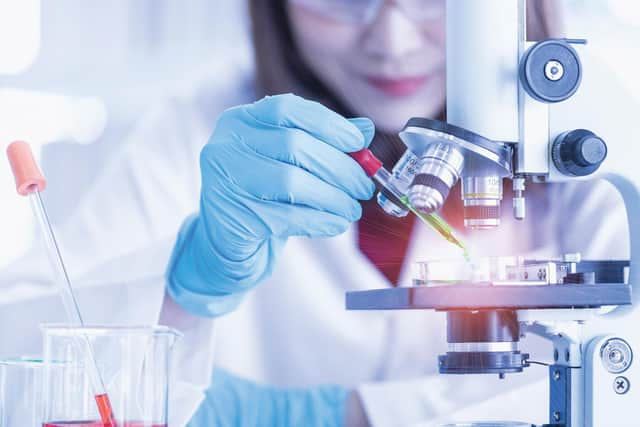Deals: Providing a catalyst for real growth
And, in a sign of confidence, the life sciences industry says it is on track to contribute £8 billion to the Scottish economy by 2025, part of the vision set by its Industry Leadership Group.
There are a combination of reasons for the success of life sciences. Chris Thompson, director of the corporate finance team at business services group AAB, says: “There are a large number of university spin-outs in life sciences and a strong ecosystem. We see quite a bit of medtech coming out of various universities, for example. There’s a well-trodden patch for university spin-outs to receive angel or VC [venture capital] investment. We have angel syndicates like Par and EOS here in Scotland and they are investing in a range of life sciences businesses and helping them grow.”
Advertisement
Hide AdAdvertisement
Hide AdGordon Steele, partner and head of deals in AAB’s corporate finance team, says: “There is a continual flow of businesses across life sciences securing funding at the lower end, often through VC and angel networks. There are Scottish success stories, such as medtech firm Current Health, where the early-stage investors will have done well. This hopefully proves that the model works.


“For the right business with the right management team and the right product and offering, there can be good investment returns.”
David Gallagher, partner in the commercial services team at law firm Brodies, is also positive about the performance of life sciences, pointing to an uptick in investment in recent months. He describes The Campbell Report: A Roadmap To Investment For Health Innovation Life Sciences And Healthtech, published at the end of last year, as providing a body of data on the sector. Dr
Ian Campbell, chief business officer at LifeArc, chaired a working group from across life sciences and health tech to explore how to attract increased levels of private investment. The report made 18 recommendations, with the aim of building an effective national life sciences cluster.
Gallagher says: “We have really solid foundations in life sciences. Some £62 million was raised in the first nine months of 2021. That was 42 per cent higher than the amount raised during the whole of 2020, and37 per cent of the total investment in Scotland across all sectors. Life sciences is punching above its weight. We also have a real critical mass of companies now.”
He explains that during the pandemic there was a lot of collaboration involving the Scottish Government and development agencies – such as Scottish Enterprise and HIE [Highlands and Islands Enterprise] – academia, and companies. “PPE is an example of an area where very mature supply chains are developing largely as a result of the pandemic,” says Gallagher. “It’s time to capitalise on all the good things that have been done around supply chains to drive innovation forward. Life sciences had to be very reactive and agile during the pandemic to quickly deal with an urgent problem. That’s when you see disruptive innovation.”
Gallagher refers to the “joined-up approach” benefits of the £40-million BioHub on Aberdeen’s Foresterhill Health Campus, led by the University of Aberdeen, to help grow businesses. Another example is the new Life Sciences Innovation Centre in Inverness.
Turning to deals, Gallagher highlights Biocaptiva, a University of Edinburgh spin-out that is developing the BioCaptis, a cell-free DNA capture device designed to transform liquid biopsy testing for cancer management. It announced an oversubscribed £2.1m additional seed funding round in June. The financing was led by existing investor Archangels, joined by Scottish Enterprise, Cancer Research Horizon and Old College Capital.
Advertisement
Hide AdAdvertisement
Hide AdHe talks about Antibody Analytics opening the Discovery Centre in Motherwell and aiming to increase staff numbers by 50 per cent this year. “They are a leading light within the pharma service sector globally,” he says. Another deal he refers to is Edinburgh-based Nodus Oncology’s acquisition of IP assets from Basilea Pharmaceutica International.
“Such deals are showing we now have maturity in the life sciences sector, ecosystem and infrastructure to develop clinical assets all the way through to treating patients,” he says.
In terms of what is attracting investors, Gallagher believes they see value in Scotland’s life sciences sector and they like the partnership approach.
To put this in context, he says £366m was spent on research and development, in what the Scottish Government describes as life sciences, across the country – this was 25 per cent of total R&D investment in Scotland. The sector’s Gross Value Added (GVA) has been steadily increasing and now stands at nearly £88,000 per head of population, compared to the average of £55,000 across all sectors.
Looking forward, Gallagher concludes: “I think the recommendations of the Campbell Report will be followed and implemented.
“One of the things that was suggested was to create a digital platform to encourage collaboration, and to form a register of Scottish-based intellectual property and make this visible on the global stage. That would encourage external investment from the rest of the UK and internationally.”